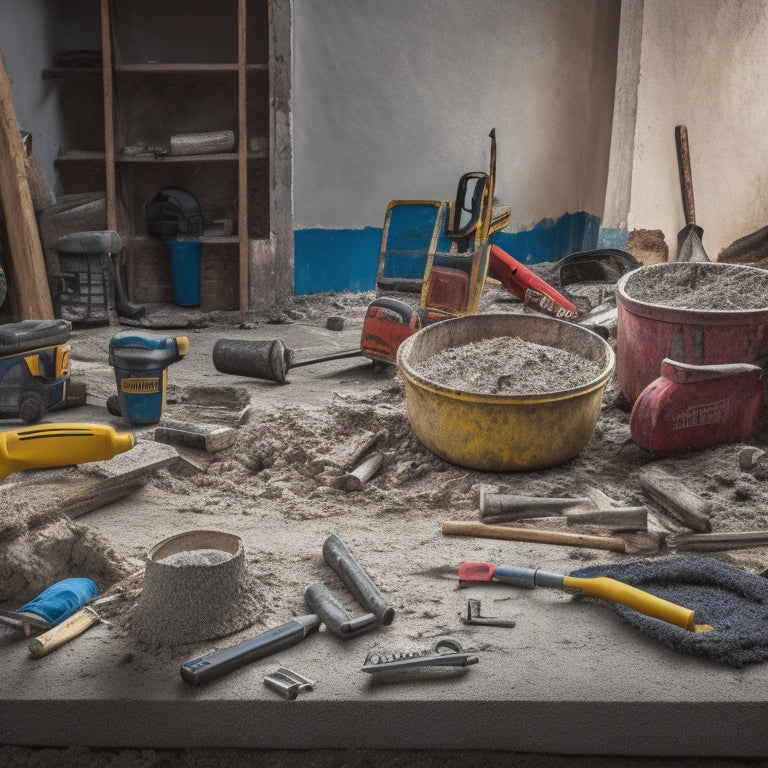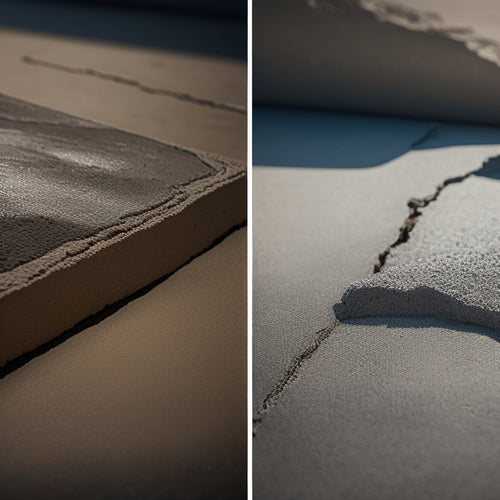
What Tools Do You Need to Remove Concrete
Share
You'll need a combination of specialized tools, including concrete saws, demolition hammers, jackhammers, chisels, pry bars, and wedges, along with essential safety gear, to effectively remove concrete from your project site. Concrete saws provide precise cuts, demolition hammers handle smaller areas, and jackhammers tackle thicker slabs. Pry bars and wedges offer control and precision for targeted removal. Don't forget safety gear like gloves, goggles, and dust masks to protect yourself. With the right tools and gear, you'll be ready to tackle your concrete removal project - and a closer look at each tool's specifics will help you get the job done efficiently.
Key Takeaways
• Concrete saws and demolition hammers are essential for making precise cuts and breaking up concrete floors and walls.
• Jackhammers, chisels, and pry bars are necessary for breaking up and removing concrete blocks and slabs.
• Safety gear, including gloves, goggles, dust masks, and steel-toed boots, is critical for protecting yourself from injury.
• The type of concrete and removal method determine the specific tools and techniques required for the job.
• Bit selection and compatibility with the jackhammer and concrete type are crucial for effective concrete removal.
Demolition Tools for Concrete
When tackling a concrete removal project, you'll need to equip yourself with the right demolition tools for concrete to efficiently break up and dismantle the structure.
Concrete saws are a must-have for making precise cuts through thick concrete slabs or walls. These powerful machines can be electric or gas-powered and come in various blade sizes to suit your specific needs.
Demolition hammers, on the other hand, are ideal for breaking up smaller areas of concrete or for demolishing concrete floors. They're available in electric, pneumatic, or hydraulic models, each with its own advantages.
You'll also want to take into account the type of demolition hammer bits or chisels you'll need, as they vary depending on the concrete's hardness and your desired outcome.
Additionally, safety gear such as gloves, goggles, and a dust mask are essential to protect yourself from flying debris and hazardous dust particles.
With the right demolition tools for concrete, you'll be well-equipped to tackle even the most challenging concrete removal projects.
Breaking Up Concrete Blocks
You'll need to employ a combination of force and technique to break up concrete blocks, which can be dense and stubborn. To achieve this, it's vital to understand the removal techniques that work best for concrete blocks.
Start by identifying the type of concrete block you're dealing with, as this will influence your approach. For instance, if you're working with a hollow concrete block, you may be able to use a pry bar to dislodge it from its surrounding structure.
For solid concrete blocks, you'll need to use more aggressive removal techniques, such as applying pressure with a wrecking bar or using a hammer and chisel to create cracks.
It's important to wear protective gear, including gloves, safety glasses, and a dust mask, to prevent injury from flying debris and concrete dust.
Jackhammer and Chisel Options
Several jackhammer and chisel options are available for removing concrete, each with its own strengths and weaknesses that you should evaluate. When choosing a jackhammer, you'll need to decide between electric, pneumatic, and hydraulic types, each with its own power source and advantages. Chisel techniques also vary, from using a pointed chisel for breaking up thin layers to a flat chisel for prying up thicker slabs.
Here are some key factors to evaluate when selecting a jackhammer and chisel:
-
Jackhammer types: Electric jackhammers are lightweight and portable, pneumatic jackhammers are powerful and reliable, and hydraulic jackhammers offer high force and low vibration.
-
Chisel techniques: Use a pointed chisel for breaking up thin layers, a flat chisel for prying up thicker slabs, and a spade chisel for removing concrete in tight spaces.
-
Bit selection: Choose the right bit size and type for your jackhammer and the type of concrete you're removing.
- Safety features: Look for jackhammers and chisels with safety features such as vibration reduction, ergonomic handles, and protective guards.
Pry Bar and Wedge Methods
By employing pry bar and wedge methods, you can effectively remove concrete without relying on heavy machinery, making them ideal for smaller-scale projects or situations where noise and vibration need to be minimized.
These techniques allow for more control and precision, enabling you to target specific areas of concrete for removal.
To begin, use pry bar techniques to create a gap between the concrete and the underlying surface. This can be achieved by inserting the pry bar into a crack or joint and gently prying the concrete away.
Once a gap is created, you can use wedge placement to further separate the concrete from the surface. Strategically place wedges into the gap, tapping them gently into place with a hammer.
As you continue to pry and wedge, the concrete will begin to break away, allowing you to remove it in manageable sections.
Safety Gear for Removal
When removing concrete, at least three essential safety gear items - safety glasses, dust mask, and heavy-duty gloves - must be worn to protect yourself from flying debris, airborne particles, and abrasion. These protective equipment items are vital to guarantee your safety during the removal process.
Additionally, you should consider wearing:
** Steel-toed boots to protect your feet from heavy objects and tools.
** Long sleeves and pants to prevent skin abrasion.
-
A hard hat or safety helmet to protect your head from falling debris or tools.
-
Earplugs to reduce the risk of hearing loss from loud machinery.
Frequently Asked Questions
Can I Reuse Concrete After It's Been Removed?
When you're done removing concrete, you're probably wondering if you can reuse it. The answer is yes, but it depends on the condition and type of concrete.
Reusing concrete offers benefits like reduced waste and lower construction costs. You can opt for concrete recycling methods like crushing and re-aggregating, or re-purposing it as aggregate material.
However, you'll need to assess the concrete's quality and verify it meets the required standards for reuse.
How Do I Dispose of Broken Concrete Safely?
Did you know that the US generates over 500 million tons of concrete waste annually?
When it comes to disposing of broken concrete safely, you've got options. You'll want to explore concrete recycling options, such as crushing and repurposing it as aggregate or using it as a base material.
Alternatively, consider concrete disposal methods like sending it to a landfill or dumping it in a designated concrete recycling facility.
Whatever you choose, make sure to follow local regulations and take necessary precautions to avoid environmental harm.
Can I Remove Concrete in Extreme Weather Conditions?
When you're planning to remove concrete, you're likely wondering if extreme weather conditions will hinder your progress. The answer is, it depends.
While concrete removal techniques can be adapted to accommodate weather conditions, extreme temperatures, humidity, or precipitation can greatly impact the process.
For instance, high temps can cause concrete to become more brittle, making it easier to break, but excessive rain can make the site hazardous.
Are There Any Environmental Concerns With Concrete Removal?
As you commence on the concrete removal journey, beware of the environmental landmines lurking beneath the surface.
You'll need to navigate the complex terrain of concrete recycling and minimize the environmental impact of your project.
Remember, concrete demolition can release hazardous materials into the air and water, so it's vital you follow proper protocols to mitigate these risks.
Do I Need a Permit to Remove Concrete in My Area?
You'll need to check with your local government to determine if you need a permit to remove concrete in your area.
Permit requirements vary depending on the scope and location of your project.
Research local regulations and ordinances to guarantee compliance.
Failing to obtain necessary permits can result in fines, penalties, or even project shutdown.
Don't risk it – verify the requirements before you start removing concrete.
Conclusion
You've got the tools, you've got the skills, and you've got the determination to take on that concrete removal job.
But before you start, remember that the real challenge is yet to come - the actual removal process.
Will you be able to break up the concrete blocks and haul them away without a hitch?
Can you outsmart the stubborn chunks that refuse to budge?
The clock is ticking, and it's time to put your skills to the test.
Related Posts
-

Must-Have Tools for Laying Concrete Tiles
When laying concrete tiles, you'll need a range of essential tools to get the job done right. Start with subfloor pre...
-

7 Must-Have Tools for Concrete Repair Organization
To effectively organize your concrete repair projects, you'll need a thorough toolkit that includes a well-planned st...
-

What Tools Ensure Strong Concrete Adhesion at Home
You'll need the right tools to guarantee strong concrete adhesion at home. For surface preparation, use concrete surf...


